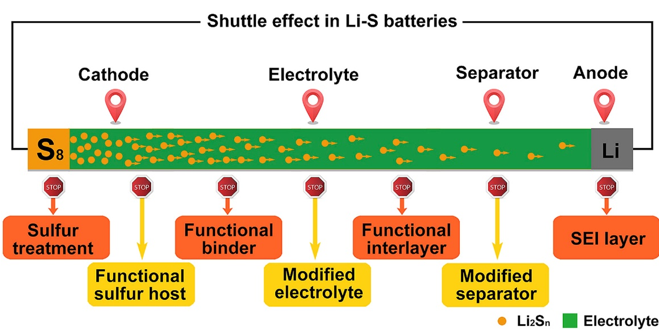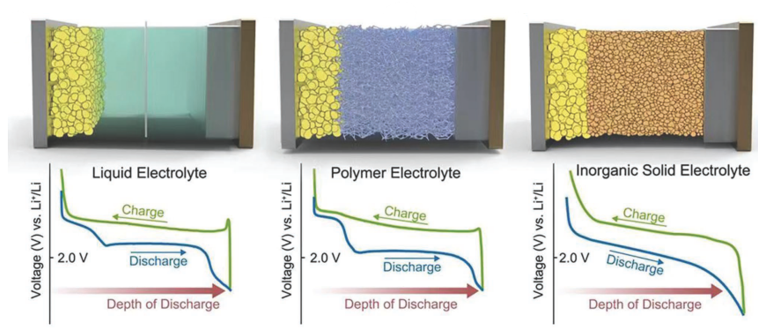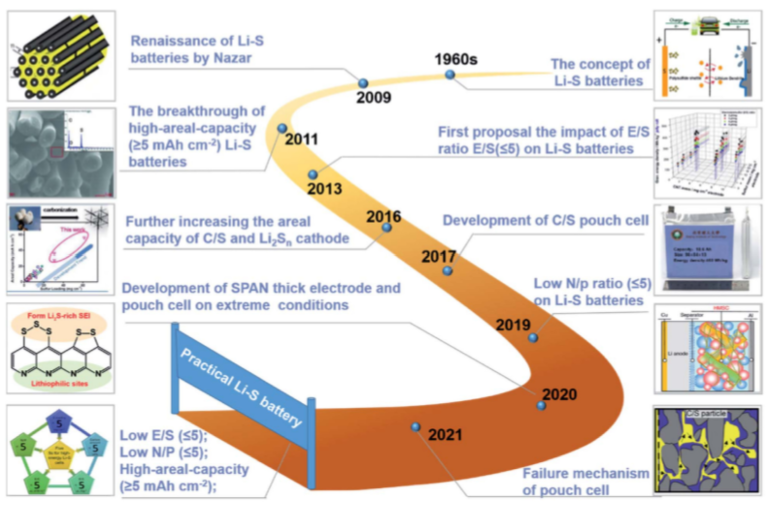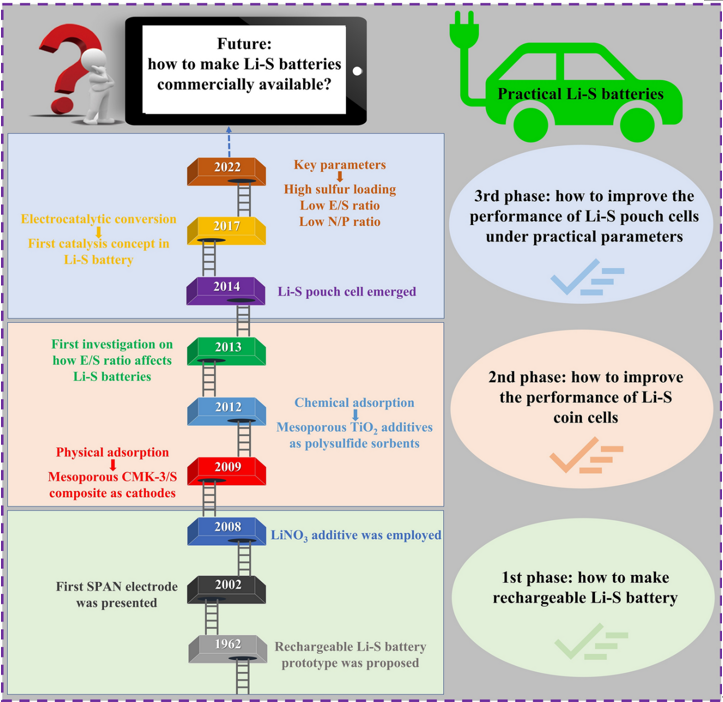<2024> Li-S Battery Technology Development Status and Outlook
Lithium-Sulfur
(Li-S) batteries are lithium-ion secondary batteries (LIBs) that use sulfur or
sulfur compounds as cathode active materials, and often use metallic lithium or
its alloys for anode materials. Since sulfur can attract two lithium atoms or
release two electrons with one atom, it can theoretically achieve a gravimetric
energy density of 1675 mAh/g, which is about 10 times that of existing LIBs,
but in reality, development is underway aimed at realizing gravimetric energy
of about twice that.
Since
Li-S batteries do not use expensive metal materials such as cobalt or nickel,
their carbon footprint is 60% lower than that of general LIBs and 40% lower
than that of all-solid-state batteries, making them more eco-friendly to
produce. This has the potential to significantly improve battery performance,
making them a strong candidate for next-generation batteries that can
simultaneously provide low cost and improved performance.
Until now, the cycle life of
charging-discharging processes has often been as short as around 200 cycles.
This is primarily because sulfur from the cathode dissolves into the
electrolyte or forms polysulfides (Li2Sx), which do not revert to the original sulfur,
leading to rapid degradation of the original electrode structure. Additionally,
since sulfur itself is an insulator, a large amount of conductive additives is
needed for its use as a cathode, which has prevented the energy density from
reaching theoretical levels. Researchers have been tackling these issues
through extensive trial and error.
However,
in 2022, researchers from Drexel University in the U.S. reported achieving a
cycle life of 4,000 times. Development cases by battery manufacturers are also
increasing. For instance, the US company Lyten reported over 1,400 cycles for a
cell designed for electric vehicles in 2021. Additionally, Japanese company
ADEKA announced in November 2022 that they had achieved over 5,000 cycles at an
energy density of 100 Wh/kg and over 200 cycles at 450 Wh/kg. Furthermore, in
November 2023, ADEKA revealed a prototype cell with an impressive weight energy
density of 803 Wh/kg, the highest level ever achieved for lithium-ion
batteries.
Recently, there
has been an active movement to provide samples to car makers. Lyten received
investment from European car maker Stellantis in 2023, and began shipping
pilot-produced cells to Stellantis in May 2024, and announced that it would be
shipping samples to more than 20 companies in late 2024. Currently, it is a
pouch-type cell, but it is said that cylindrical cells will also be
manufactured in late 2024. These can be manufactured at half the material cost
of existing LIBs, and the manufacturing yield is also said to be high at over
90%.
Li-S
Energy (Australia) started operating a pilot production line with a capacity of
2MWh/year in 2024. They are now planning to build a large-scale production
facility with a capacity of GWh per year.
In
2023, Gelion (UK) acquired the intellectual property of OXIS Energy, which went
bankrupt in May 2021. Using this technology, they announced a cell with an
energy density of 395 Wh/kg in April 2024 and plan to start sample shipments in
2026.
In
China, Zhongke Paisi Energy Storage Technology has been producing 35 Ah, 609
Wh/kg battery cells at a pilot scale since 2017 and is expanding production for
advanced solar drones, EVs, and power storage applications.
LG
Energy Solution, a global battery manufacturer, has also been researching Li-S as
one of next-generation batteries since 2015. By applying the pouch outer
material, introducing a new combination of electrolytes, and effectively
controlling the volume with the know-how accumulated over many years, the lifespan
has been increased, and it is intended for use in urban air mobility (UAM) and
high-altitude unmanned aerial vehicles (UAVs), and the goal is
commercialization in 2027. Meanwhile, in the case of high-altitude UAVs, it can
be used for 6 months with 200 times of charges, and it is said that the
condition required by the OEM is 400-500Wh/kg and used more than 200 times.
This
report provides a comprehensive overview of the development of Li-S secondary
batteries, including major technological advances, related technological
obstacles, and component/material developments. It also focuses on the latest
emergence of cell configurations that promise a leap forward in Li-S secondary
battery research. It also introduces advanced characterization techniques that
can help understanding the mechanisms involved in the chemistry of Li-S
secondary batteries, and provides an introduction to research programs in
various countries, covering the academic and practical applications of research
results to date.
Strong
Points of this report
① Summary of the concept of Li-S batteries and
historical development trends
②
Understanding of Li-S battery technical
obstacles and the status of component/material development
③ Latest trends in Li-S battery cell development
material composition
④ Presentation of Li-S battery application cases
by major companies
⑤
Introduction to the
status of Li-S battery-related patent applications and future development
directions

<Recent
advances in shuttle effect inhibition for Li-S batteries>


< Overview of Li-S battery development from concept
proposal to present & Roadmap for Li-S batteries >

< A brief timeline and key events in the development of Li-S batteries >


< Support projects for next-generation batteries_Li-S
batteries >
Table of Contents
1. Overview of
Lithium-Sulfur Secondary Batteries
9
1-1. Need for Lithium-Sulfur Secondary Batteries 9
1-2. History of Lithium-Sulfur Secondary Batteries 12
1-3. Principles of Lithium-Sulfur Secondary Batteries 16
1-4. Technical Issues of Lithium-Sulfur Secondary Batteries 21
1-4-1. Insulation of Sulfur
21
1-4-2. Formation of Dissolved Substances and Shuttle Effect 21
1-4-3. Formation of Insoluble Substances (Li2S) 25
1-4-4. Self-Discharge Phenomenon
25
1-4-5. Use of Lithium Anodes
28
1-4-6. Use of Thick Sulfur Electrodes 29
1-5. Commercialization of Lithium-Sulfur Secondary Batteries 30
1-5-1. Important Parameters for High-Energy-Density Lithium-Sulfur
Batteries 32
1-5-2. Industrialization of Lithium-Sulfur Batteries 35
2. Development
Status of Sulfur Cathode Technology for Lithium-Sulfur Secondary
Batteries 37
2-1. Traditional Sulfur Composite Electrode 37
2-2. Sulfur-Porous Carbon Composite Materials 38
2-2-1. Sulfur-Porous Carbon Composite Materials 38
2-2-1-1. Carbon Materials
39
2-2-1-2. Sulfur-Carbon Composite
39
2-2-1-3. Synthesis Methods
47
2-2-2. Sulfur-Graphene Composite Materials 50
2-2-2-1. Graphene and Graphene Oxide 50
2-2-2-2. Sulfur-Graphene/Graphene Oxide Composite 50
2-2-3. Binder-Free Sulfur-Carbon Composite Electrode 52
2-3. Sulfur-Graphene Composite Materials 55
2-3-1. Sulfur-Polyacrylonitrile Composite 55
2-3-2. Sulfur-Polypyrrole Composite
56
2-3-3. Sulfur-Polyaniline Composite
57
2-3-4. Other Sulfur-Conductive Polymer Composites 59
2-4. Binder-Free Sulfur-Carbon Composite Electrode 61
2-4-1. Metal Oxide Additives
61
2-4-2. Metal Oxide Coatings
62
2-4-3. Metal Sulfide Complexes 63
2-4-4. Intercalation Compounds 63
2-5. Catalyst Materials for Sulfur Cathodes 63
2-5-1. Metal Sulfide Catalysts 64
2-5-2. Metal Oxide Catalysts 66
2-5-3. Single-Atom Catalysts 68
2-5-4. Defect Site Catalysts 69
2-5-5. Quantum Dot Catalysts 71
2-5-6. Heterostructure Catalysts 72
2-5-7. Other Catalyst Materials 74
3. Development Status of Lithium
Sulfide (Li2S) Cathode Technology for Lithium-Sulfur Secondary Batteries
76
4. Development Status of Anode
Technology for Lithium-Sulfur Secondary Batteries 81
5. Current Status of Electrolyte,
Separator, and Binder Technology Development for Lithium-Sulfur Secondary
Batteries 97
6. Configuration of Lithium-Sulfur Secondary Battery Cell 125
6-1. Intermediate Layer
125
6-1-1.
Polysulfide Barrier Mechanism 126
6-1-2. Materials for the Intermediate Layer
127
6-2. Porous Current Collector 128
6-2-1. Sulfur Impregnation Strategy
129
6-2-2. Materials for Porous Current Collector 130
6-3. Sandwich Electrode 130
6-4. Dissolved Polysulfide Anolyte
131
6-5. Voltage Window of Lithium-Sulfur Secondary Battery 132
6-5-1. Upper Voltage Plateau
133
6-5-2. Lower Voltage Plateau 133
7. Analysis Techniques and Mechanistic
Understanding of Lithium-Sulfur Secondary Battery 133
7-1. In-Situ Analysis 134
7-2. Polysulfide Dissolution 135
7-3. Formation of Protective Layer 136
7-4. Kinetics 138
8. Development of All-Solid Lithium-Sulfur
Batteries 140
8-1. Summary 140
8-2. Current Status of LIBs 141
8-3. Necessity of All-Solid Lithium-Sulfur
Batteries 143
8-3-1. Safety Issues of LIBs 143
8-3-2. Increasing Demand for
High-Energy-Density Batteries 146
8-3-3. Raw Material Supply and
Sustainability Issues 148
8-4. Basics of All-Solid Lithium-Sulfur
Batteries 149
8-4-1. Sulfide-Based Solid Electrolytes 151
8-4-1-1. Glass Solid Electrolytes 151
8-4-1-2. Crystalline Materials 152
8-5. Sulfide-Based Cathodes 156
8-5-1. Sulfur 156
8-5-2. Metal Sulfides 158
8-5-3. Organic Sulfur 158
8-5-4. Li2S 159
8-6. Anode Materials for All-Solid
Lithium-Sulfur Batteries 160
8-6-1. Lithium Metal Anodes 160
8-6-2. Lithium Alloy Anode Materials 161
8-6-3. Silicon Anode Materials 162
8-7. Redefining Four Challenges of All-Solid
Lithium-Sulfur Batteries 162
8-7-1. Interface Stability 162
8-7-2. Lithium Dendrites 164
8-7-3. Volume Expansion and Electrochemical
Instability 166
8-7-4. Processing Issues 167
8-7-5. Regulatory Approval and
Standardization 167
8-8. Five Strategies for Accelerating
Commercialization of All-Solid Lithium-Sulfur Batteries 168
8-8-1. Performance Enhancement 168
8-8-2. Cell Design Improvements for Enhanced
Efficiency 170
8-8-3. Strategies for Large-Scale
Fabrication 172
8-8-4. Wet Coating Process 173
8-8-5. Dry Coating Process 174
8-8-6. Infiltration Process 175
8-9. Summary and Outlook 176
9. Energy Density Formula for
Practical Li-S Battery Design 177
10. Current Status of Lithium-Sulfur Battery
Development Companies 188
10-12. Zhongke
Paisi Energy Storage Technology Co., Ltd5
10-13. Shaanxi
Guoneng New Materials Co., Ltd(陕西国能新材料有限公司)67
11. Current Status of Major Patent Applications and Future Directions in
Technology Development 268
12. Recent Developments in Lithium-Sulfur Batteries 276
13. References 303

